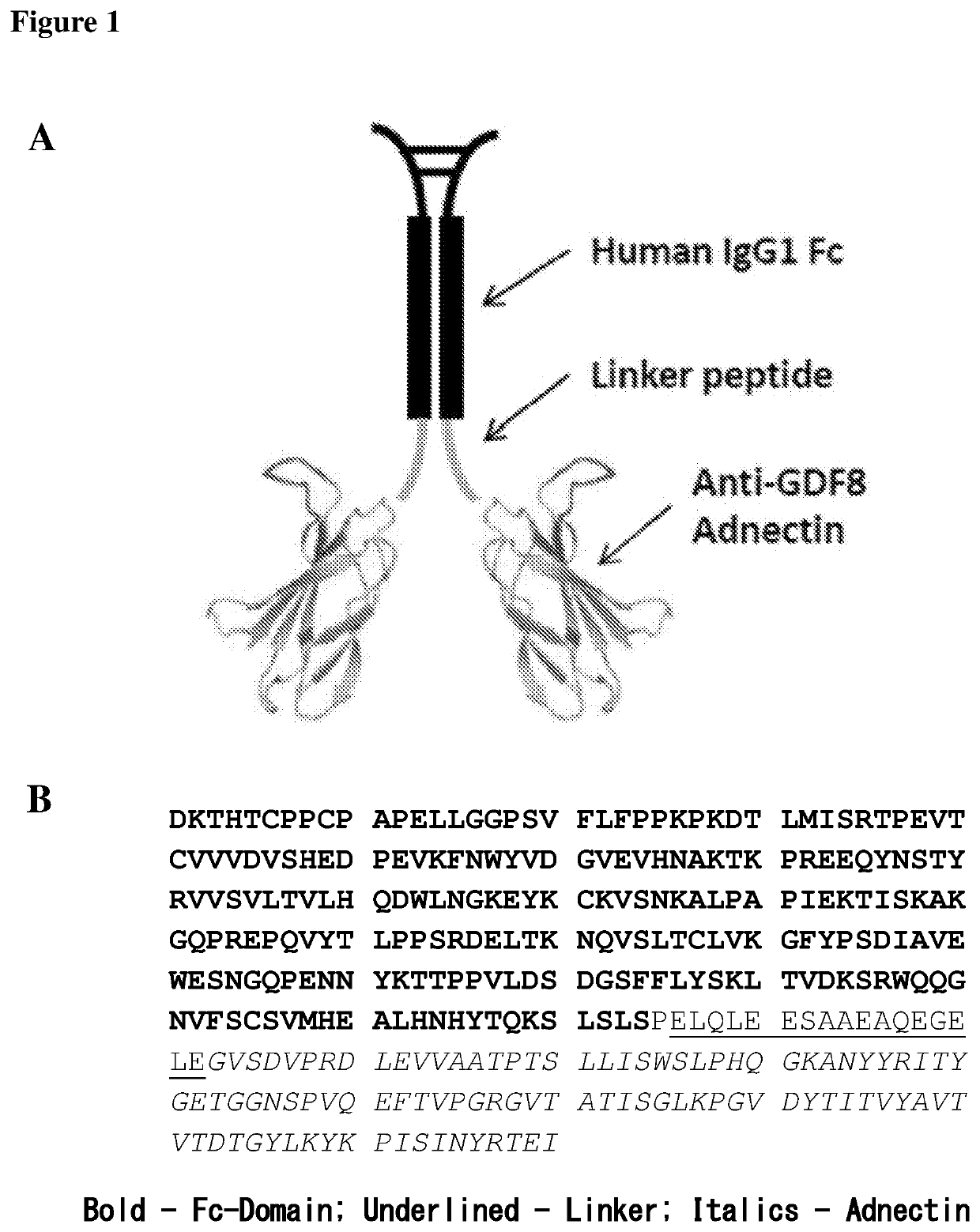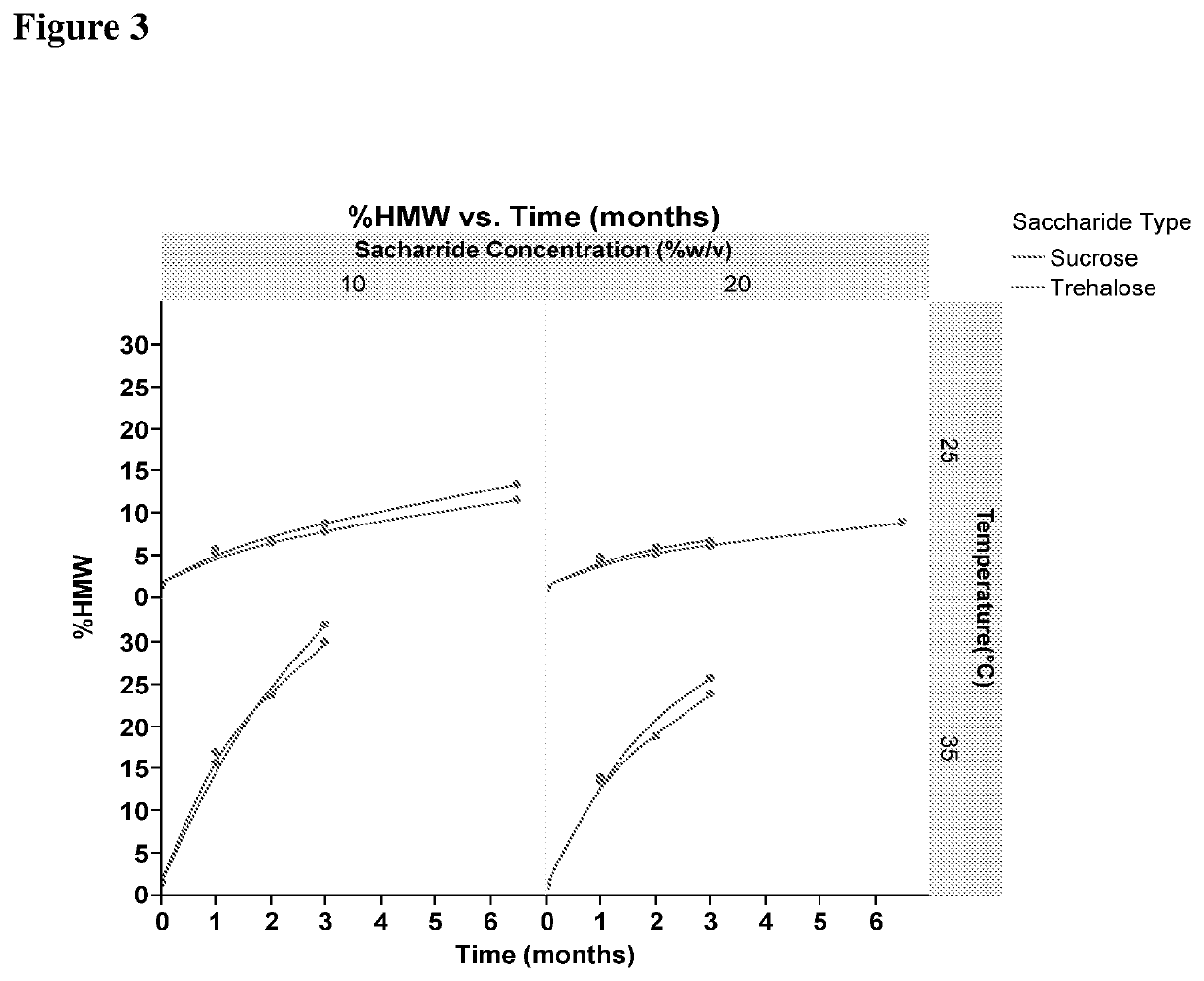Stable formulations of fibronectin based scaffold domain proteins that bind to myostatin
a technology of scaffold domain proteins and myostatin, which is applied in the direction of peptide/protein ingredients, drug compositions, muscular disorders, etc., can solve the problems of unsuitable osmolality and/or viscosity increase, and achieve the effect of increasing muscle mass, muscle strength and/or metabolism
- Summary
- Abstract
- Description
- Claims
- Application Information
AI Technical Summary
Benefits of technology
Problems solved by technology
Method used
Image
Examples
example 1
A. Expression and Purification of Anti-Myostatin Adnectins
[0439]Methods for cloning, expressing and purifying insoluble and soluble anti-myostatin adnectins have been previously described (U.S. Pat. Nos. 8,933,199; 8,993,265; 8,853,154; and 9,493,546). Briefly, nucleic acids encoding an anti-myostatin adnectin are cloned into a pET9d vector and expressed in E. coli BL21 DE3 plysS cells. Twenty ml of an inoculum culture (generated from a single plated colony) are used to inoculate 1 liter of LB medium or TB-Overnight Expression Media (auto induction) containing 50 μg / ml Kanamycin and 34 μg / ml chloramphenicol. Cultures in LB medium are incubated at 37° C. until A600 0.6-1.0 and then induced with 1 mM isopropyl-β-thiogalactoside (IPTG) and grown for 4 hours at 30° C. Cultures grown in TB-Overnight Expression Media are incubated at 37° C. for 5 hours, at which time the temperature was lowered to 18° C. and grown for 19 hours. Cultures are harvested by centrifugation for 30 minutes at 10...
example 2
[0454]In this study, % HMW formation and % LMW formation was studied for anti-myostatin adnectin in 25 mM Histidine buffer, pH 6.9 containing either Sucrose or Trehalose sugars.
TABLE 1Anti-myostatin adnectin drug product (DP) propertiesDescriptionDimer of anti-human myostatin antagonist adnectinwhich has been formatted with a human IgG1 wild typeFc (monomer -SEQ ID NO: 78)MolecularApproximately 75,587 DaltonsWeightAppearanceClear to slightly opalescent, colorless to pale yellowsolution, essentially free of particulate matterPackagingSchott 5-cc type I borosilicate glass vial (SAP#1334424) with a 20-mm Daikyo butyl D-21-7-Sreformulated B2-40 / Flurotec stopper (SAP# 1292587ready-to-use or 1239067 ready-to-sterilize) and 20-mmflipoff seal (SAP# 1187393)
TABLE 2MaterialsCSONameRoleManufacturerSAP#Catalog #Lot #DrugActiveBMS—PR14018SubstanceIngredientL-HistidineBufferJ T Baker—2080-06J42609SucroseExcipientBMS10200562J73171TrehaloseExcipientFerro—T-104-1-33265ADihydrate(Pfanstiehl)MCSchott ...
example 3
[0469]In this example, the viscosity of certain formulations containing the anti-human myostatin antagonist adnectin-Fc fusion dimer from Example 2 was measured in centipoises as indicated in the following Table 11 and FIG. 4 (The trehalose (tre) and sucrose (suc) are indicated in the legend). The measurements were done as function of protein concentration and temperature of solution. The data indicate that formulations containing high disaccharide concentrations (550 mM) generally exhibit viscosities suitable for subcutaneous use at a wide range of anti-myostatin adnectin concentrations. The data also indicate lower viscosities of the solutions containing trehalose as compared to the viscosities of the solutions, under the same temperature and protein concentration, containing sucrose.
TABLE 11Viscosity (cP)Protein20 mM Histidine,20 mM Histidine,Conc.Temperature550 mM Sucrose,550 mM Trehalose,(mg / mL)(° C.)pH 7.0pH 7.01053.33.310102.82.810202.12.110251.81.810351.41.45055.05.250104.24...
PUM
| Property | Measurement | Unit |
|---|---|---|
| concentration | aaaaa | aaaaa |
| concentration | aaaaa | aaaaa |
| concentration | aaaaa | aaaaa |
Abstract
Description
Claims
Application Information
 Login to View More
Login to View More - R&D
- Intellectual Property
- Life Sciences
- Materials
- Tech Scout
- Unparalleled Data Quality
- Higher Quality Content
- 60% Fewer Hallucinations
Browse by: Latest US Patents, China's latest patents, Technical Efficacy Thesaurus, Application Domain, Technology Topic, Popular Technical Reports.
© 2025 PatSnap. All rights reserved.Legal|Privacy policy|Modern Slavery Act Transparency Statement|Sitemap|About US| Contact US: help@patsnap.com



